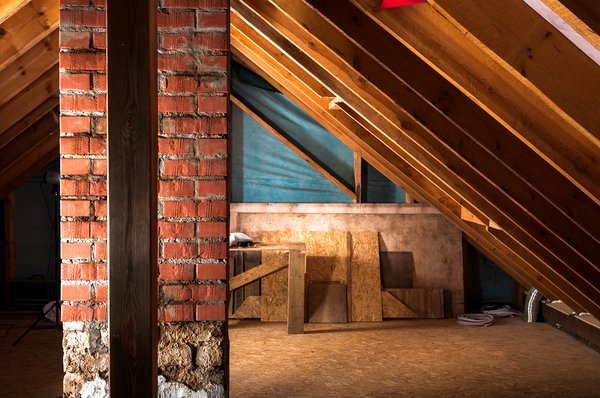
The attic can reveal many issues during a home inspection.
When you’re doing a home inspection, the attic is a critically important part.
Why? Because it shows you the underside of the roof, and the roof is one of the most expensive parts of a house to replace.
Since home inspectors are rarely required to climb on a roof, they can only inspect it from the ground or from a ladder leaned up against the eaves. Home inspectors who use drones to assess the condition of the roof have a definite advantage, but drone usage isn’t common, and it doesn’t preclude the need to inspect the attic.
What should you look for when inspecting an attic?
-
- Leaks/water damage — This is the most serious problem you can find with a roof. If the underside of the roof is wet or shows signs of having been wet, such as water stains or mold growth, repairs or a replacement is in order.When inspecting the roof from the attic, pay special attention to the underlayment around the chimney, vents, skylights, or any other areas of penetration. Poke the wood with a pencil or another pointy object to see if it’s soft or gives at all. Use a moisture meter too, to detect water that may not be visible to the naked eye.
- Insulation — No insulation in an attic is a huge red flag. It’s a big siphon for HVAC. But just the presence of insulation is not always enough. If the insulation is old, it might be doing little good. Over the years, insulation can settle and provide less of a buffer between the house and the outdoors.That means in the winter, heat is escaping through the roof, and in the summer, the proximity of the hot attic to living spaces makes the A/C run overtime. Both waste money and energy.
Baby birds are cute, but not in the attic.
- Evidence of Infestation — Attics are favored spots for critters. Mice, rats, squirrels, raccoons, opossums, birds, and bugs all love to call an attic home. They get shelter from the weather, added warmth, and some snuggly insulation to make a nest.Signs of rodents in the attic include nesting materials, droppings, and gnawed wood.
- Ventilation — Improper or inadequate ventilation can cause premature rotting to the roof decking. Attics need a cross breeze and good insulation, or otherwise, the heat from the home will rise, penetrate the roof, and be trapped in the attic. In the winter, this can cause the snow on the roof to melt and form ice dams at the eaves.Angie’s List recommends checking attic vents to make sure they are not blocked by rodent nests or debris.
- Other damage — Realtor.com says home inspectors should also keep an eye out for fire or structural damage, sagging or bending areas of the roof, and cracks or crumbling in the chimney brickwork.
When entering an attic to perform an inspection, always make sure you have a powerful flashlight, a dust mask, an AFCI/GFCI tester, gloves, safety goggles, a moisture meter, an infrared camera, and your phone to take pictures to document your findings.
Performing home inspections can be dangerous work, so always remember to put your safety first. To learn home about home inspection, check out our website today!









